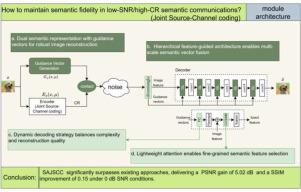带辅助语义的无线图像传输深度联合源信道编码
IF 2.2
4区 计算机科学
Q3 ENGINEERING, ELECTRICAL & ELECTRONIC
引用次数: 0
摘要
语义通信作为一种新兴的范式,通过将深度学习(DL)与联合源信道编码(DeepJSCC)相结合,取得了显著的成功。然而,目前的方法难以完全适应语义信息的动态复杂性,在传输过程中,特别是在低信噪比(SNR)和高压缩场景(CR)的环境中,由于特征同质性和噪声鲁棒性不足,往往会导致关键细节的丢失。因此,我们提出了一种新的双语义语义通信框架——带辅助语义的无线图像传输深度联合源信道编码(SAJSCC),该框架利用引导向量生成网络(GVNet)提取图像特定的引导向量,并明确地为主要特征流和辅助语义构建互补空间。该解码器集成了层次化特征引导机制,采用双解码策略动态平衡计算效率和重构保真度。此外,我们还设计了一个信道与空间同步注意模块(CCSAM),该模块通过联合信道与空间重加权来抑制噪声干扰。实验评估表明,提出的SAJSCC框架显著优于现有的方法,在0 dB信噪比条件下,其峰值信噪比(PSNR)增益为5.02 dB,结构相似指数(SSIM)改进为0.15。我们的框架显著增强了复杂纹理的恢复,为高鲁棒性语义通信建立了新的范式。本文章由计算机程序翻译,如有差异,请以英文原文为准。

Deep joint source-channel coding for wireless image transmission with auxiliary semantics
Semantic communication, as an emerging paradigm, has achieved significant success by combining deep learning (DL) with joint source-channel coding (DeepJSCC). However, Current methods struggle to fully adapt to the dynamic complexity of semantic information, often suffering from loss of key details due to feature homogeneity and insufficient noise robustness during transmission, especially in environments with low signal-to-noise ratio (SNR) and high compression scenarios (CR). Therefore, we propose a novel dual-semantic framework for semantic communication, the deep joint source-channel coding for wireless image transmission with auxiliary semantics (SAJSCC), which employs a guidance vector generation network (GVNet) to extract image-specific guidance vectors, and explicitly constructs complementary spaces for the primary feature stream and auxiliary semantics. The decoder integrates a hierarchical feature guidance mechanism, adopting dual decoding strategies to dynamically balance computational efficiency and reconstruction fidelity. Furthermore, we design a concurrent channel-and-spatial attention module (CCSAM) that suppresses noise interference through joint channel–spatial re-weighting. Experimental evaluations show that the proposed SAJSCC framework significantly surpasses existing approaches, delivering a peak signal-to-noise ratio (PSNR) gain of 5.02 dB and a structural similarity index measure (SSIM) improvement of 0.15 under 0 dB SNR conditions. Our framework significantly enhances the recovery of complex textures, establishing a new paradigm for highly robust semantic communication.
求助全文
通过发布文献求助,成功后即可免费获取论文全文。
去求助
来源期刊

Physical Communication
ENGINEERING, ELECTRICAL & ELECTRONICTELECO-TELECOMMUNICATIONS
CiteScore
5.00
自引率
9.10%
发文量
212
审稿时长
55 days
期刊介绍:
PHYCOM: Physical Communication is an international and archival journal providing complete coverage of all topics of interest to those involved in all aspects of physical layer communications. Theoretical research contributions presenting new techniques, concepts or analyses, applied contributions reporting on experiences and experiments, and tutorials are published.
Topics of interest include but are not limited to:
Physical layer issues of Wireless Local Area Networks, WiMAX, Wireless Mesh Networks, Sensor and Ad Hoc Networks, PCS Systems; Radio access protocols and algorithms for the physical layer; Spread Spectrum Communications; Channel Modeling; Detection and Estimation; Modulation and Coding; Multiplexing and Carrier Techniques; Broadband Wireless Communications; Wireless Personal Communications; Multi-user Detection; Signal Separation and Interference rejection: Multimedia Communications over Wireless; DSP Applications to Wireless Systems; Experimental and Prototype Results; Multiple Access Techniques; Space-time Processing; Synchronization Techniques; Error Control Techniques; Cryptography; Software Radios; Tracking; Resource Allocation and Inference Management; Multi-rate and Multi-carrier Communications; Cross layer Design and Optimization; Propagation and Channel Characterization; OFDM Systems; MIMO Systems; Ultra-Wideband Communications; Cognitive Radio System Architectures; Platforms and Hardware Implementations for the Support of Cognitive, Radio Systems; Cognitive Radio Resource Management and Dynamic Spectrum Sharing.
 求助内容:
求助内容: 应助结果提醒方式:
应助结果提醒方式:


